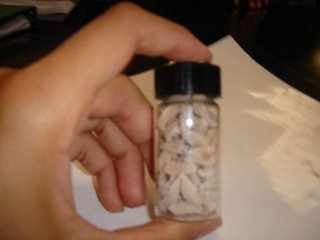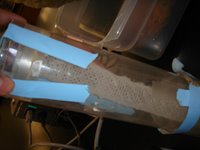KINGDOM: Metazoa (animals)
Subkingdom: parazoa: the "p" category--only two phyla
- Phylum Porifera--sponges (sponges have PORES!), acoelomic, have choanocytes which flow water through the sponge through porocytes and out the osculum (the mouth of the sponge at the top). there are three body types: asconoid, which is just a big single cavity, syconoid, which have side chambers, and leuconoid, which have side chambers coming off the other side chambers...geez..
- Class Calcerea, made of calcium carbonate (no DUH); scypha/grantia are examples. this is an actual picture of it from the lab--if you see a jar of these, it is scypha/grantia. the purple blob is a widthwise slice.

- Hexactinellida (hexa--six pronged) has six pronged spicules...looks like two mercedes benz logos stuck together. it is a long white delicate tube thing in lab.

- Desmospongidae--spongy sponges. the ones in your house.
- sclerospongidae--hard sponges. not sure what they look like...google says this:
- Phylum Placozoa: (small multicellular animals found in aquariums...like, placozoa, the ugly plaque on the wall or something?) ;-)
Eumetazoa: "eu-" means real--these are real animals. there are two superphyla (its a bird! its a plane! NO! its superphyla!) Radiata, and Bilatera.
- Superphyla Radiata: diploblastic (only endo and ectoderm) show radial symmetry (hence the name).
- Phylum Cnidaria--jellyfish, anemones, corals. have ocelli (light sensitive yet not quite an eye), mesoglea (the gooey stuff in jellyfish!) and cnidocytes to sting prey. these hurt...trust me. there are polyps (looking up, an anemone) and medusa (looking down, a jellyfish). There are three classes to know:
- Class Hydrazoa, polyp dudes..which include hydra, obelia, Portugese man-o-war. the man o war is NOT a medusa, the top part is an air bladder.
- Class Scyphozoa, jellyfish.
- Class Anthozoa (remember last exam, anthophyta, the flowers? antho- means flower) corals and anemones.
- Phylum Ctenophora; lack cnidocytes
- Superphylum Bilatera includes everything else.
- (Acoelomic) Phylum Platyhelminthes; the flatworms. triploblastic beauties! hermaphroditic! squishy! Classes:
- Class Trematoda, which has two subclasses, Digenea, the disgusting worms that live in your liver and intestines (Chinese liver fluke and Schistosoma mansoni--know life cycles) and Monogenea (parasitic of fish gills).
- Class Cestoda, tapeworms. they have a scolex (attachment part to host) a strobilus composed of proglottids (reproductive units that make eggs)
Examples are Taenia saginata (human beef, sheep, pork, fish) tapeworm and Dipyllidium caninum (dog tapeworm). know the life cycles!
- (Acoelomic) Phylum Nemertea (proboscis worms)
- (Pseudocoelomic) Phylum Nematoda, dioecious, free living and parasitic, some parasitic examples include Trichinella (pork worms), Enterobius (pinworms), Ascaris (we dissected these, the white worms), and Ancylostoma (hookworms)
- There are some other phylums of these worms, you should read about them in the study guide.
- (Eucoelmic) Phylum Mollusca; they have a well developed circulatory system and heart; all members (almost!) posses a radula, a plate in their mouth that scrapes food...like a spatula...lol. a mantle which is a bunch of cells that secrete a shell and a cavity with gills and siphons. a foot for moving around. and well developed organs. the classes are:
- Class Gastropoda (snails and slugs)
- Class Pelecypoda/Bivalvia: Clams, oysters, etc.
- Class Cephalopoda: Octopus, squid, cuttlefish.
- KNOW LIFE CYCLES.
- Phylum Annelida; segmented worms. triploblastic, protostomates, septa separate each segment, have setae (WORM HAIR!!!!)
- Class Hirudinea, leeches; have posterior sucker. no photo, you should know what a leech looks like. :-)
- Phylum Arthropoda (joint footed animals). Have chitin in exoskeleton; some external segmentation; many are social (party animals...he he)
- Subphylum Chelicerata; lack antennae, with two oral appendages (like fangs, pinchers, etc.), have book gills/lungs; typically four pairs of walking legs; two body regions, the cephalothorax (cephalo- means head, thorax- means thorax..uh..) which is the head and thorax joined together, and the abdomen.
- Subphylum Crustacea; cephalothorax and abdomen, two pairs of antennae.
- Class Branchiopoda, fairy shrimp and water fleas.
- Class Copepoda
have one very long antennae, held at right angles...this poor thing has to cope with his long antennae. poor copepoda.
- Class Cirripedia, barnacles. Very serious creatures they are indeed.
- Class Malacostraca; they have a rostrum, carapace, abdomen, and telson (i don't think you need to worry about these parts of the animal).
- Subphylum Uniramia; in other words, lovely insects.
- Class Insecta; head, thorax, abdomen; one pair of antennae; three pairs of walking legs; spiracles which allow air to flow through to have gas exchange occur (they are like lungs, but not). Metamorphosis is either complete (egg > larva > pupa > adult) or incomplete (egg > nymph [which is a small adult] > adult)
- Please, please, look at the orders yourself.
- Class Chilopoda, centipedes. They are chillin. They have one leg on each segment of their body.
- Class Diplopoda, millipedes. they have two legs on each segment of their body. (di- two, diplopoda, two legs a segment? yeah? we good? jk/jk)

